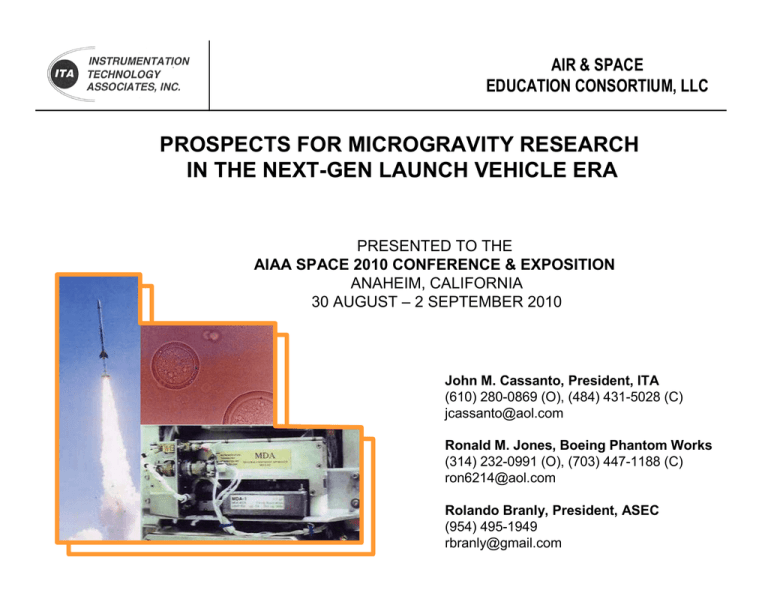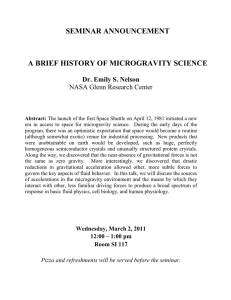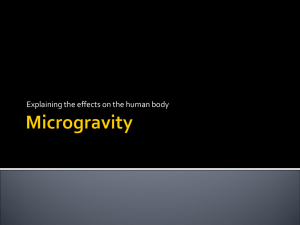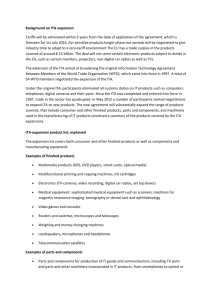2010 AIAA Space 2010 Prospects for micro-g Research 8-27-10
advertisement

AIR & SPACE EDUCATION CONSORTIUM, LLC PROSPECTS FOR MICROGRAVITY RESEARCH IN THE NEXT-GEN LAUNCH VEHICLE ERA PRESENTED TO THE AIAA SPACE 2010 CONFERENCE & EXPOSITION ANAHEIM, CALIFORNIA 30 AUGUST – 2 SEPTEMBER 2010 John M. Cassanto, President, ITA (610) 280-0869 (O), (484) 431-5028 (C) jcassanto@aol.com Ronald M. Jones, Boeing Phantom Works (314) 232-0991 (O), (703) 447-1188 (C) ron6214@aol.com Rolando Branly, President, ASEC (954) 495-1949 rbranly@gmail.com TODAY’S REALITY • Today we are at the threshold of a new generation of commercial launch (Nextgen) earth to space vehicles • Unfortunately, the microgravity community from the previous era has been largely decimated and must be resuscitated • Fortunately, unlike the beginning of the previous generation, flight proven Shuttle and EELV era commercial hardware is available for use by a new generation of µ-gravity users and researchers • Capable of supporting a wide array of research areas (Biomedical, Fluid Physics, Manufacturing Processes Research) • Enabling stepping stone research: aircraft to suborbital to orbital • Secondary Research Payloads represent a significant potential market & additional revenue stream for Nextgen space launch providers • High value biomedical research & manufacturing processes /experiments • Education experiment opportunities (Grade school thru College level) 2 TODAY’S REALITY CONTINUED • Payload processing and integration void/opportunity remains to be filled • New commercial µ-gravity facilitators like NanoRacks, LLC offering researchers extended stay opportunities at ISS • CubeLab approach applicable to a variety of future platforms • ITA Microgravity hardware is available today for lease to conduct low-g aircraft, suborbital or orbital microgravity experimentation • ASEC thru an agreement with NanoRacks will be flying legacy ITA hardware on STS-134 • Commercial, academic and student space education experiments manifested • Research opportunities still available (see me after the talk) • Now planning for STS-135 opportunity and beyond! 3 Next-Gen Launch Companies Changing Space Paradigm • Infusing much needed competition into moribund space industry • ConOps offering hope for lowering costs to orbit • Will enable new era of microgravity research • Secondary payloads offer additional revenue stream • But… new P/L processing and Integration industry must raise to occasion • Don’t wait for the dinosaur aerospace industry! 4 ITA’S THREE DECADES OF SPACE PROCESSING HARDWARE RESEARCH AND DEVELOPMENT 9 Space Shuttle Missions Early 1980’s 2010 5 ITA’S SPACE PROCESSING HARDWARE OVERVIEW 6 SPACE PROCESSING µ-GRAVITY HARDWARE RESEARCH APPLICATIONS • Hardware can be used to conduct a wide range of research: – Materials science/industrial applications – Diffusion studies – – – – – – Cell research Biomedical research Protein crystal growth Thin film membranes Chemistry Inorganic crystals via furnace hardware • Stepping stone aircraft research prior to suborbital flight • Stepping stone experiments prior to orbital flight • Available to piggyback on near-term space tourism missions – Suborbital or Orbital 7 ITA’S COMMERCIAL MICROGRAVITY HARDWARE CHARACTERISTICS HARDWARE SIZE ANALOG WEIGHT NO. SAMPLES CIGARETTE PACK ~ 6 OUNCES 16 BRICK ~ 4 Lbs 90 BOOK ~8 Lbs 290 SMALL BREADBOX ~16 Lbs ~ 500 with 9 optical wells Single 8 ITA HARDWARE BASED ON SLIDING BLOCK TECHNOLOGY Specific gravity of samples drives diffusion rates on Earth Liquid-Liquid Diffusion With samples with equal specific gravity Liquid-Liquid Diffusion With samples with different specific gravity 9 MDA (MATERIALS DISPERSION APPARATUS) – DMDA (DUAL MATERIALS DISPERSION APPARATUS ) SPACE PROCESSING HARDWARE EVOLUTION • • • • • • Four low-g Aircraft flights Six Consort, One Joust, One Brazilian VS-30 sounding rocket missions Nine Space Shuttle Mid-Deck Locker missions One Meteor/Comet orbital flight (destroyed) One Mir Space Station mission One International Space Station mission (MEPS) 1st Gen MDA 2nd Gen MDA 3rd Gen MDA Flown on Aircraft & Suborbital Rockets Flown on Suborbital Rockets & Space Shuttle Flown on Space Shuttle ITA HARDWARE • 22 Space Missions • 13 Space Shuttles 1st Gen DMDA & DMDA-O 2nd Gen DMDA & DMDA-O Flown on Space Shuttle Flown on Space Shuttle & Mir 10 DMDA MICROGRAVITY HARDWARE HAS VIDEO CAPABILITY DURING SPACE OPERATIONS DMDA-O (OPTICAL) CAPABILITIES HUMAN HAIR PRE LAUNCH LAUNCH + 3 HOURS LAUNCH + 10 HOURS END OF MISSION 9 DAYS SCREEN LYSOZYME CRYSTAL GROWTH 11 NANORACKS FACILITATING RESEARCH OPPORTUNITIES AT REASONABLE COSTS ON ISS 4” CubeLab at heart of system 12 EXAMPLES OF COMMERCIAL MICROGRAVITY SOUNDING ROCKET DATA 13 SOUNDING ROCKET µ-GRAVITY RESEARCH LED TO NEW DRUG DELIVERY SYSTEM First Microcapsules were made in space aboard Consort 4 Sounding Rocket using ITA Hardware Microcapsules formed During 6 minutes of flight ITA’S MDA Space Processing Hardware Consort 4 launched out of White Sands, NM 14 SOUNDING ROCKET µ-GRAVITY RESEARCH LED TO IMPROVED THIN FILM POLYMER MEMBRANES 1 g (~ Earth) µ-gravity (~ Space) Ground Sample Microgravity Sample 500X magnification 500X magnification Photos courtesy of the Battelle Advanced Materials Center for the Commercial Development of Space 15 EXAMPLES OF ORBITAL RESEARCH RESULTS Demonstrating the benefit of suborbital research as a stepping stone to extended duration research in orbit 16 GROUND VS SPACE: ITA UROKINASE SPACE RESEARCH RESULTS Urokinase: To our knowledge, these crystals have never been grow larger than ~50 microns on Earth Typical of Earth grown sizes achieved 1991 BIMDA-2, STS 43 LESS THAN 50 MICRONS - TOO SMALL - UNSTABLE 1993 CMIX-2, STS-56 ~ 50 MICRONS - STILL TOO SMALL - UNSTABLE 1996 CMIX-5, STS-80 350 - 500 MICRONS - LARGE - UNSTABLE 1998 CBIX-1 STS 95 - 350 MICRONS - LARGE, STABLE - POOR DIFFRACTION BECAUSE OF INSUFFICIENT PURITY OF UROKINASE UTILIZED 17 CONCLUDING REMARKS • Commercial flight heritage microgravity hardware exists to meet a broad range of nextgen suborbital and orbital user needs • Secondary payloads offer an additional revenue stream to nextgen launch providers • Payload processing and integration represents a significant opportunity for the commercial space sector • Flight proven space processing hardware is available for lease to conduct low-g, suborbital, or orbital microgravity experiments • Research opportunities exist on STS-134 and beyond using ASEC payload processing services with legacy hardware and Nanoracks. Those interested please see me here at the conference. Anyone need a ride? 19 AIR & SPACE EDUCATION CONSORTIUM www.itaspace.com For Further Information John M. Cassanto, CEO, ITA (PA) 610.280.0869 (O), 484.431.5028 (C) jcassanto@aol.com Ronald M. Jones, Boeing Phantom Works (MO) 314.232.0991 (O), 703.447.1188 (C) ron6214@aol.com Professor Rolando Branly, Broward College (FL) Air & Space Education Consortium, LLC 954.201.6676 (O), 954.495.1949 (C) rbranly@gmail.com 20 BACKUP CHARTS 21 DEMONSTRATION & TRAINING HARDWARE 22 MDA EXPERIMENT APPLICATIONS MATRIX FOR CONSORT 3 SOUNDING ROCKET FLIGHT 23 GROUND VS SPACE COMPARISON OF SPACE GROWN BOVINE COLLAGEN 1 g (~ Earth) Ground Sample µ-gravity (~ Space) Flight Sample STS-95 • Essentially no microfibrils • Collagen precipitates consisted entirely of large bundles 700-800 angstroms • Bundles randomly dispersed with large open spaces • Collagen aggregates grow from a few nucleation sites forming thick filaments • Spoke-like opaque regions containing microfibrils • Random precipitation of connected microfibrils • Size: 80-90 angstroms, occasional large collagen bundles 200-300 angstroms diameter • Between spokes are large transparent areas devoid of collagen • Fibril nucleation occurs at many independent sites leading to many thin microfibrils 24 GROUND VS SPACE COMPARISON: PLANARIA REGENERATION STUDENT EXPERIMENT Discovery: Regeneration of Planaria cells in space is different than on Earth Ground Control Planaria Flight Planaria Who woulda thought? 25 GROUND VS SPACE: LYSOZYME CRYSTAL GROWTH MDA Minilab using Liquid-Liquid Diffusion 1 g (~ Earth) Ground Sample µ-gravity (~ Space) Flight Grown Sample 26 ITA TEST SUCCESS… ANOTHER WORLD FIRST • First Diffused “Vodka” Martini • 16 May 1990 • Experiment should be repeated with Gin….. Just to do it! 27



